
Exploring Nutrients and Metals in Coastal Sea Fish
Jim Crocker
20th March, 2024

Image Source: Natural Science News, 2024
Key Findings
- Study from Sardar Bahadur Khan Women's University found three fish species are rich in protein and lipids
- Trace metals in these fish are within safe limits, posing no significant health risk
- Iron was unexpectedly absent, and Titanium was detected for the first time in Sardinella abella
EnvironmentNutritionMarine Biology
References
Main Study
1) Trace metals and nutrient analysis of marine fish species from the Gwadar coast.
Published 19th March, 2024
https://doi.org/10.1038/s41598-024-57335-0
Related Studies
2) Impacts of Some Trace Metals in Cyprinus carpio (Linnaeus, 1758) and Tor soro (Valenciennes, 1842) on Human Health.
3) Bioaccumulation of heavy metals in Rastrelliger kanagurta along the coastal waters of Visakhapatnam, India.
4) Accumulation of Trace Metals in Indigenous Fish Species from the Old Brahmaputra River in Bangladesh and Human Health Risk Implications.



 11th March, 2024 | Jenn Hoskins
11th March, 2024 | Jenn Hoskins